
In 1903, the Romanovs, Russia’s last and longest-reigning royal family, held a lavish costume ball. It was to be their final blowout, and perhaps also the “last great royal ball” in Europe, writes the Vintage News. The party took place at the Winter Palace in St. Petersburg, 14 years before Czar Nicholas II’s abdication, on the 290th anniversary of Romanov rule. The Czar invited 390 guests and the ball ranged over two days of festivities, with elaborate 17th-century boyar costumes, including “38 original royal items of the 17th century from the armory in Moscow.”
“The first day featured feasting and dancing,” notes Russia Beyond, “and a masked ball was held on the second. Everything was captured in a photo album that continues to inspire artists to this day.” The entire Romanov family gathered for a photograph on the staircase of the Hermitage theater, the last time they would all be photographed together.
It is like seeing two different dead worlds superimposed on each other—the Romanovs’ playacting their beginning while standing on the threshold of their last days.
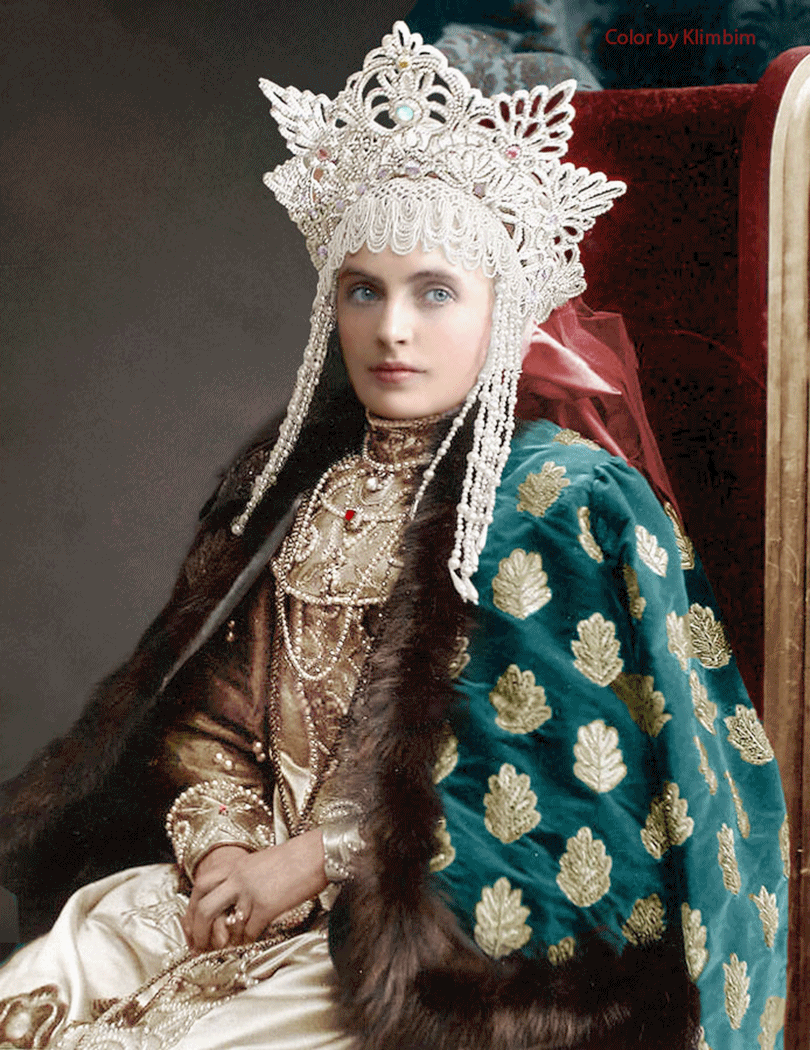
With the irony of hindsight, we will always look upon these poised aristocrats as doomed to violent death and exile. In a morbid turn of mind, I can’t help thinking of the baroque gothic of “The Masque of the Red Death,” Edgar Allan Poe’s story about a doomed aristocracy who seal themselves inside a costume ball while a contagion ravages the world outside: “The external world could take care of itself,” Poe’s narrator says. “In the meantime it was folly to grieve or to think. The prince had provided all the appliances of pleasure…. It was a voluptuous scene, that masquerade.”
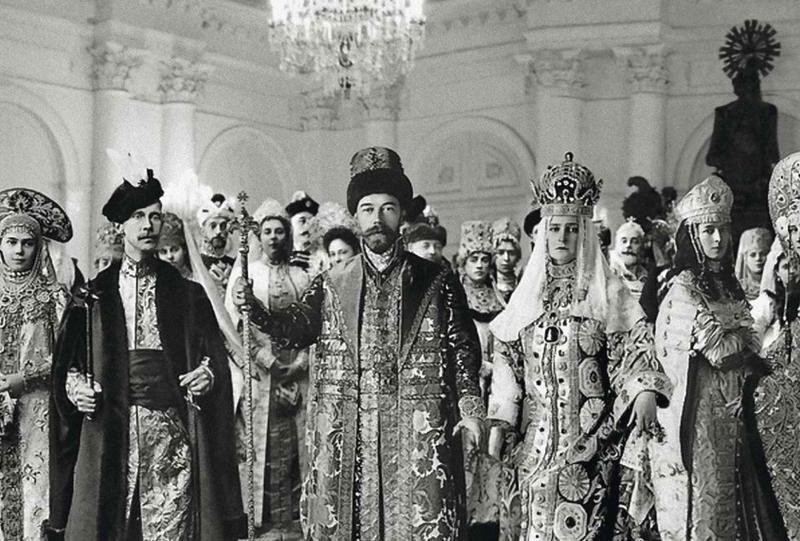
Maybe in our imagination, the Romanovs and their friends seem haunted by the weight of suffering outside their palace walls, in both their country and around Europe as the old order fell apart. Or perhaps they just look haunted the way everyone does in photographs from over 100 years ago. Does the colorizing of these photos by Russian artist Klimbim—who has done similar work with images of WW2 soldiers and portraits of Russian poets and writers—make them less ghostly?
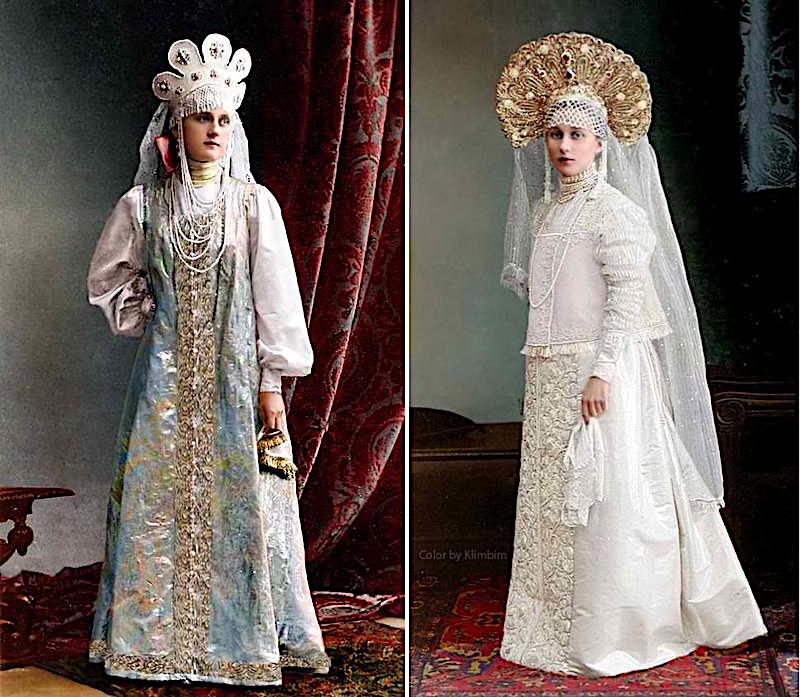
It puts flesh on the pale monochromatic faces, gives the lavish costuming and furniture texture and dimension. Some of the images almost look like art nouveau illustrations (and resemble those of some of the finest illustrators of Poe’s work) and the work of contemporary painters like Gustav Klimt. Maybe it’s just me, but it seems that unease lingers in the eyes of some subjects—Empress Alexandra Fedorovna among them—a certain vague and troubled apprehension.

In their book A Lifelong Passion, authors Andrei Maylunas and Sergei Mironenko quote the Grand Duke Alexander Mikhailovitch who remembered the event as “the last spectacular ball in the history of the empire.” The Grand Duke also recalled that “a new and hostile Russia glared though the large windows of the palace… while we danced, the workers were striking and the clouds in the Far East were hanging dangerously low.” As Russia Beyond notes, soon after this celebration, “The global economic crisis marked the beginning of the end for the Russian Empire, and the court ceased to hold balls.”
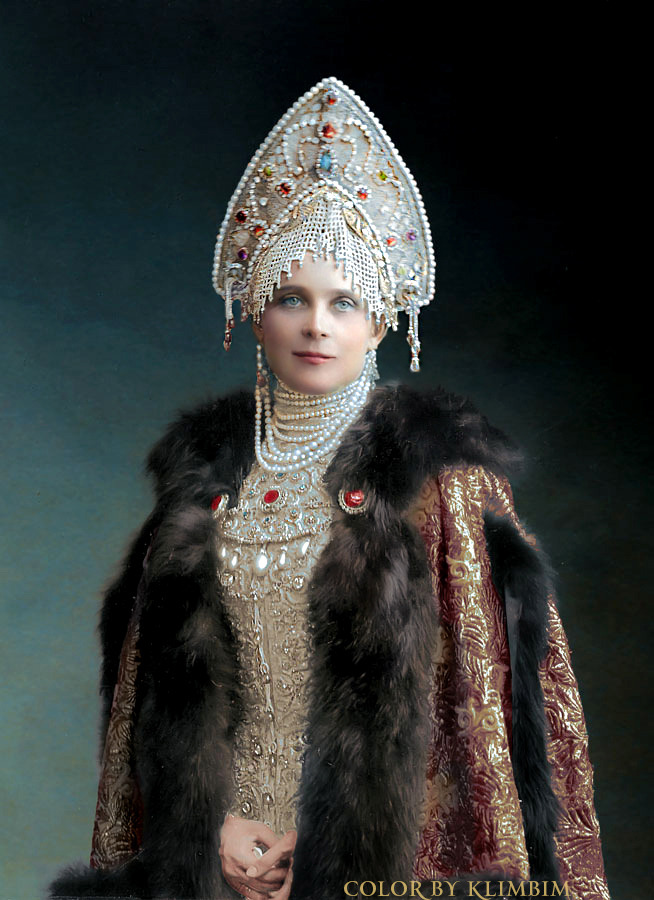
In 1904, the Russo-Japanese War began, a war Russia was to lose the following year. Then the aristocracy’s power was further weakened by the Revolution of 1905, which Lenin would later call the “Great Dress Rehearsal” for the Revolutionary takeover of 1917. While the aristocracy costumed itself in the trappings of past glory, armies amassed to force their reckoning with the 20th century.
Who knows what thoughts went through the mind of the tzar, tzarina, and their heirs during those two days, and the minds of the almost 400 noblemen and women dressed in costumes specially designed by artist Sergey Solomko, who drew from the work of several historians to make accurate 17th-century recreations, while Peter Carl Fabergé chose the jewelry, including, writes the Vintage News, the tzarina’s “pearls topped by a diamond and emerald-studded crown” and an “enormous emerald” on her brocaded dress?
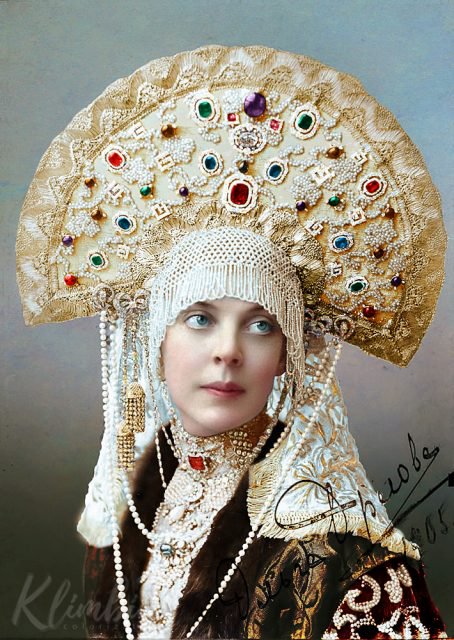
If the Romanovs had any inkling their almost 300-year dynasty was coming to its end and would take all of the Russian aristocracy with it, they were, at least, determined to go out with the highest style; the family with “almost certainly… the most absolutist powers” would spare no expense to live in their past, no matter what the future held for them. See the original, black and white photos, including that last family portrait, at History Daily and Russia Beyond, and see several more colorized images at the Vintage News.
Related Content:
Tsarist Russia Comes to Life in Vivid Color Photographs Taken Circa 1905–1915
Colorized Photos Bring Walt Whitman, Charlie Chaplin, Helen Keller & Mark Twain Back to Life
How Obsessive Artists Colorize Old Photographs & Restore the True Colors of the Past
Josh Jones is a writer and musician based in Durham, NC. Follow him at @jdmagness


They cared more for their people than the monsters that martyred them. Now their people, having suffered through inhuman oppression, celebrate them fondly on this day.
You would do well to remember that decades and centuries from now they will still be remembered and celebrated, but the snide nonsense you regularly try to pass off as ‘culture’ will have vanished like so much flatulence.
Steve
I doubt that.. … if the Romanovs had cared for their people.… they probably wouldn’t have been deposed. Thing is, if your people suffer they will have a tendency to revolt and engage in Revolution.
It would be nice when all of humanity could evolve to an enlightened place and get along and not destroy the planet or each other… when we will all be self reliant and work together. sigh.. but I fear it won’t ever be.
Bloody Sunday — 22 January 1905 in St Petersburg, Russia
Unarmed demonstrators, led by Father Georgy Gapon, were fired upon by soldiers of the Imperial Guard as they marched towards the Winter Palace to present a petition to Tsar Nicholas II of Russia.
Provoked massive strikes. The start of the Revolution of 1905.
The killing of people whm had seen the Tsar as their “Little Father”, resulted in a surge of bitterness towards Nicholas and his autocratic rule. A widely quoted reaction was “we no longer have a Tsar”.
https://en.wikipedia.org/wiki/Bloody_Sunday_(1905)
The reason we work is for sumptuous art and creativity to happen. If you work for bread and rice you get bread and rice and everyone dies of boredom.
Margaret, I fear you are correct.
Whilst it was terribly sad that the Czar and his family met with such a horrible end, they were totally oblivious to the plight of their people. The children were innocent casualties.
Revolutions are not surprising when the masses are pushed to the limit…
His cousin, King George could have saved them.….and tried, I think.
But the UK govt saw them as a liability and stopped the “rescue”
Please correct the beginnen of the article, they were not the longest ruling royal family.
Also, as much as some want to believe that revolution brought a solution to people’s suffering, revolution doubled it if not trippled it with economical reformation of the first years afterwords. While the top of Bolsheviks inhabited the houses of the former nobility. Not the best trade in the history.
King George actually decided that he better stay out of the situation all together as he didn’t want to stir trouble for the British Royal Family. He feared that he was seen to help the Romanov family he would be seen as not caring for the people. The British Government thought the same. They all feared revolution in Britain.
Whatever happened to all the historical items? So much got lost during those times of revolution — destroyed or sold. The Russian people have had a terrible history of oppression. It didn’t seem to matter who was in charge. They still suffered tremendously. The tragedy of Russia.
Beautiful! But it would have been helpful for the photos to have captions telling us who the people were.
Thanks for that quote. I needed to absorb that.
The saddest part was all the beauty and splendor of this era went away w/ the revolt.
The Czar was hardly the type of man to lead a nation, picking a German Czarina wasn’t the best idea either.
A lot has been heard of the Royal family having their jewels sewn into their clothing when executed. Has any of the Royal jewels ever been recovered?
La Belleza existe y hay que admirarla como tal, los trajes, las joyas y el trabajo que implicaron, son increibles.
Y el trabajo de ponerles color, es espectacular.
Sin duda las caras de las personas, mas allá de si son o no los Romanof, son caras hermosas, excepto la de la Reyna Alejandra, que se ve tan triste, tan enojada, tan desesperada.
Veamos a las personas, las imágenes y el bello trabajo de Teresa.
El pueblo Ruso es Maravillosamente bondadoso, siempre cree que algo bueno sucederá, siempre deseando que los Zares, los Presidentes o los Camaradas Líderes, sean sus padres, son fenomenalmente trabajadores, resisten el frío y resistieron el rigor del trabajar hasta morir causado por el Psicópata de Stalin, no solo de los Rusos, sino de tantos países como Hungría, la siempre lastimada y sufrida Ucrania, no tenemos los mexicanos la menor idea de lo que sufrieron quienes debían lograr los locos sueños de un Dictador, que, sin embargo, logró como en su momento Pedro el Grande, que Rusia se comunicara, que abriera paso hacia el mar, pues antes de eso, a pesar de ser un magno territorio, el mas grande del mundo no tenía salida al mar.
Queridos todos, solo el que carga el costal sabe lo que carga, para juzgar, hay que ubicarnos en el tiempo y en las circunstancias en que cada quien vivió. El sufrimiento de poblaciones siempre es causado por ambiciones de quienes creen, realizan “mejoras” para la humanidad.
Felicidades Tereza por tan bello trabajo.
Perdón escribí Romanos en lugar de Romanof.
Buenas noches
Joe, even though Czar Nicholas didn’t have the longest reign, the Romanovs were in fact the longest ruling family of Russia.
A few weeks ago on,4k tv via youtube,in regards to the Romanov
family.It is so chilling one of the
Romanov family murderers recounts
the actual killings,+ how he wanted
to kill them. 3 ideas 1st to kill
while they sleep 2nd a bomb.3rd was
the final one. It is gut wrenching.
The recording is 3:16 long +
he is actually talking about the
best way to murder the family
A few weeks ago got a chilling
message,in regards to the Romanov
family murderers. I have a 3:16
actual recording of one of the murderers + how he recounted what
he wanted to do + how to go about
the killings 3 ideas 1st while sleeping 2nd a bomb 3rd we,know the outcome. He’s actually talking
about the best way to kill the family
I am more interested in these photos from a costume history point of view, I can only wonder at the work that went into these costumes. How much hand sewing and embroidery went in to them ? Hand sewing is labour intensive and embroidery like this can be hard on the eyes.
Would anyone nowadays l wonder consider it OK to wear actual 17th century clothes for a costume ball ?l can hear the horrified screams from costume museums.…
By the way, my interest is in the medieval period , thats another story altogether.…but a lot of royalty then came to sticky ends too
Absolute codswallop, people are lead into a revolution usually by a minority of greedy b’stards that want to usurp power.
In response to Barbara, the jewels sewn into the corsets worked quite well as bullet-proof jackets as it took longer to shoot and kill the women and girls, their execution turned into a bloodbath. Of course that jewellery would have been looted from the dead bodies. But yes, some of the Russian jewels survived and can be visited. Queen Mary bought important pieces offered to her by exiled family members, to add to the Windsor treasure-trove. I have had the pleasure of visiting the Victoria and Albert Museum in London, where on entering a strongroom inside the Museum I instantly recognized the Russian Crown Jewels displayed in their diamond-glittering glory. Several shelves of them. I wasn’t expecting that! and to be frank it was such a thrill to actually see them up close. Good on ya, Queen Mary. Her grand-daughter Queen Elizabeth II wears the Russian Diamond Fringe Tiara for grand occasions, so yes, in good hands to preserve for future generations to see and marvel over.
Steve:
Your comment is pure emotional opinion and sorely lacking any knowledge of Russian history. You might want to read up before you make such ignorant pronouncements.
Nicholas couldn’t really take one of his own people as a bride; in the Russian imperial family, you HAD to marry royalty or your partner would be seen as “unequal” and any child would be barred from the throne, so marrying foreignly was the only option. Plus, Germany and Russia had no issues with each other when the two of them married; Nicholas couldn’t have foreseen what would happen.
I don’t know the straight facts of this family, however, what little I do know is that whatever the reason for what happened to them was beyond tragic for every single person involved. Including those who did the actual murders. They had felt they suffered enough to come to the decision they did and the czar did what he was only taught to do from birth I’m sure. Plus I bet it wasn’t just is thoughts helping him decide what to do throughout his rule. It’s not just a one sided suffer.
And as far as the pictures go, absolutely breathtaking is my personal opinion. Thank you for sharing them.
Hello all!
My great grandmother lived 107 years. She was born in 1891 in Austria. She played with the daughters of Czar Nicholas. She spoke seven languages. She told me many stories about the times when she was young before she came to Ellis Island.
The one thing I remember clearly is that she loved Czar Nicholas. So I know that historians love to alter the “facts” and rewrite history to work political magic. But my great grandmother lived through those years. She saw the world change beyond anything that you or I can imagine. I’m going to give her the benefit of the doubt. Especially since I personally knew her and I know her standards were quite high.
Thank you.
Feel free to disregard as you please. Just thought I should mention it.
Sincerely,
Cyndie
Yes, I concur.
Also, my great grandmother lived 107 years. She was born in 1891 in Austria. She played with the daughters of Czar Nicholas. She spoke seven languages. She told me many stories about the times when she was young before she came to Ellis Island.
The one thing I remember clearly is that she loved Czar Nicholas. So I know that historians love to alter the “facts” and rewrite history to work political magic. But my great grandmother lived through those years. She saw the world change beyond anything that you or I can imagine. I’m going to give her the benefit of the doubt. Especially since I personally knew her and I know her standards were quite high.
Thank you.
Feel free to disregard as you please. Just thought I should mention it.
Sincerely,
Cyndie